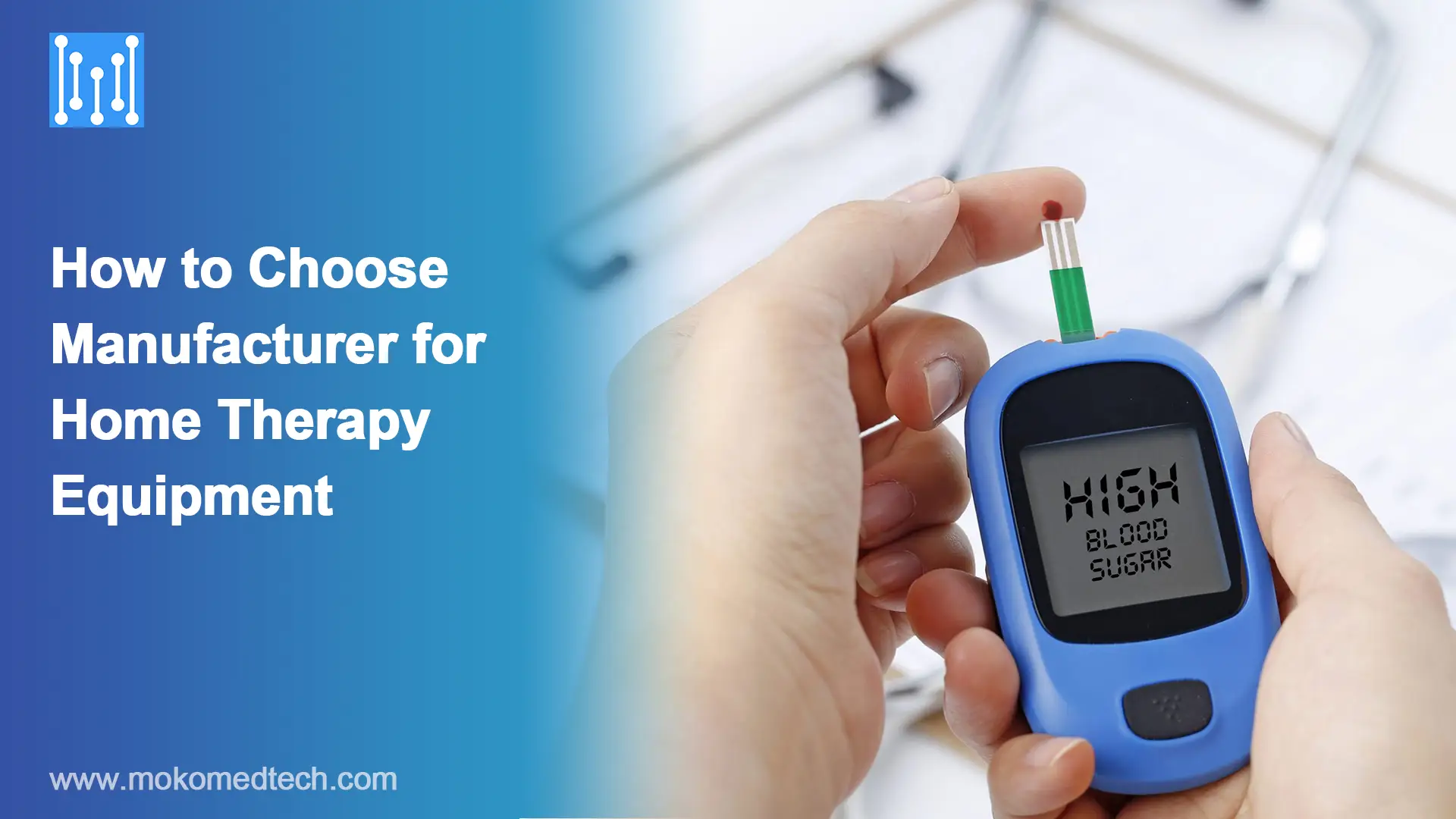Introduction to Nail Oximeter
Nail oximeter is a small, portable medical device that can measure the pulse and blood oxygen saturation of the human body through the fingertip clamping area. The device’s work is based on infrared spectroscopy technology, which can non-invasive measure blood oxygen saturation and pulse rate, making it very suitable for use in homes, clinics, first aid, and daily health care.
The use of a finger clip pulse oximeter is very simple. You only need to clamp the device finger onto your finger or toe, wait for a moment, and the results can be measured. Generally, blood oxygen saturation and pulse rate index can be directly displayed on the screen. This device usually has many practical functions, such as low battery reminder, recording and saving data, etc., which can help users monitor their physical health status at any time.
Although the finger clip pulse oximeter has a wide range of applicability and flexibility, it should be noted that the measurement results of this device are only for reference and cannot completely replace the diagnosis of doctors. If the measurement results are significantly abnormal or you feel unwell, you should seek medical attention in a timely manner.
Principle of Nail Oximeter
The measurement principle of a blood oximeter is based on the absorption spectral characteristics of reduced hemoglobin (RHb) and oxygenated hemoglobin (02hb) in the red and near red light regions, and an empirical formula for data processing is established using Lamber Beer’s law. At the same time, the machine adopts photoelectric blood oxygen detection technology combined with volumetric pulse recording technology, and irradiates the fingertip of the human nail through a perspective clamp sensor. The measurement signal is obtained by a photosensitive element, and the obtained information is processed by electronic circuits and microprocessors, and then displayed by two sets of LEDs.
A blood oximeter can detect arterial pulsation, allowing patients to understand their heart rate. At the same time, a finger oximeter can measure blood oxygen saturation or arterial hemoglobin saturation in a painless manner to prevent danger from occurring.
By using infrared light technology, the brightness of the skin and musculoskeletal tissues of the fingers can be used to detect human blood oxygen saturation and pulse rate, with performance, accuracy, and compliance with EU CE standards. When a person’s blood oxygen saturation is abnormal, the cause of the abnormality should be analyzed. It is necessary to take targeted measures in a timely manner, including early prevention, diagnosis, and treatment.
Based on the absorption spectral characteristics of reduced hemoglobin (RHb) and oxygenated hemoglobin (02hb) in the red and near red light regions, an empirical formula for data processing was established using Lamber Beer’s law. At the same time, the machine adopts photoelectric blood oxygen detection technology combined with volumetric pulse recording technology, and irradiates the fingertip of the human nail through a perspective clamp sensor. The measurement signal is obtained by a photosensitive element, and the obtained information is processed by electronic circuits and microprocessors, and then displayed by two sets of LEDs.
Measurement Method of Nail Oximeter
The measurement of pulse oxygen saturation in a pulse oximeter uses photoelectric technology, and there are usually two methods: transmission method and reflection method.
Transmission
According to Lambert Beer’s law, when a beam of light illuminates a solution of a substance, the substance absorbs and attenuates the light to a certain extent. The relationship between the transmitted light intensity(I) and the incident light intensity(I0) is as follows:

In the formula ε is the absorption coefficient of the substance; c is the concentration of the solution; d is the path through which light passes.
The logarithm of the ratio I/I0 is called absorbance D, so the above equation can be expressed as:

If the path of light remains unchanged, the absorbance is directly proportional to the absorbance coefficient of the substance and the concentration of the solution.
The absorption coefficients of oxygenated hemoglobin (HbO2) and reduced hemoglobin (Hb) in the blood are different for different wavelengths of light, as shown in the following figure. In the red light region with wavelengths of 600-700nm, the absorption coefficient of Hb is greater than that of HbO2; In the near-infrared region with a wavelength of 800-1000nm, the absorption coefficient of HbO2 is greater than that of Hb; Near 805nm is the absorption point.
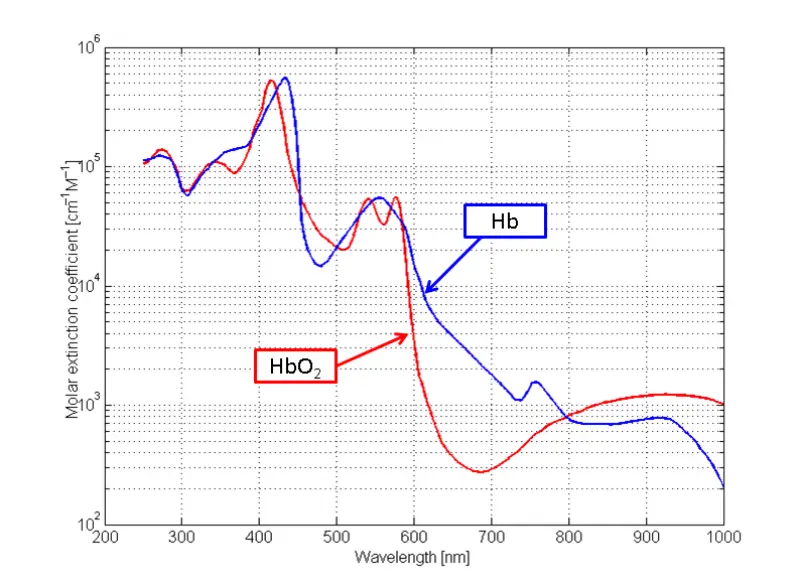
Based on the spectral characteristics of oxygenated hemoglobin HbO2 and reduced hemoglobin (Hb), the light-emitting element in the blood oxygen saturation probe emits two wavelengths of light signals. Typically, the measured tissue is illuminated with red light at around 660nm and infrared light at around 905nm. The parts containing arterial blood vessels (such as fingers, toes, earlobes, etc.) are placed between the light-emitting tube and a phototube, as shown in the figure.
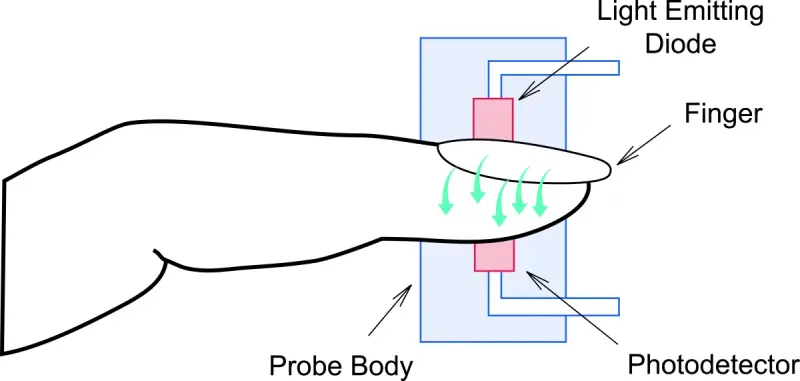
The light absorption or light transmission signal received by the photocell contains two components: the pulsating component (i.e. AC signal), which is an alternating component formed by the light absorption bow of pulsating arterial blood; Another type is the stable component (i.e. DC signal DC), which reflects the size of light absorption in various non pulsatile tissues (such as epidermis, muscles, bones, and veins). The only thing that can reflect the change in blood oxygen saturation is the ratio of the amplitude of the two wavelength AC signal, while the two wavelength DC signal can be used to calibrate the AC signal. Due to the periodic changes in HbO2 and Hb concentrations in the blood with the pulsation of the blood, their absorption of light is also pulsating. As a result, the electrical signal intensity output by the pantograph phototube also changes periodically with the pulsation of the blood. Due to the fact that the photocell can convert the received light signal into an electrical signal, but cannot distinguish the wavelength of light, a timing circuit is used in the monitor circuit to control the emission order of the two light emitting tubes. Two wavelengths of light alternately pass through the detection site, and the transmitted light intensity is detected by a photoelectric element. The pulsating components of the two signals are separated, filtered, amplified, and converted into digital signals. The corresponding blood oxygen saturation value is calculated according to the following equation:

Ired is infrared light, Red is red light. By calculating the AC to DC ratio of infrared and red light, the R coefficient is obtained, and then the R coefficient table (Table) is searched to obtain blood oxygen saturation. The R-coefficient table was obtained through blood gas experiment calibration.
Reflection Method
Sensors using the transmission principle are generally used for measuring blood oxygen saturation in most parts of the body surface, such as fingertips, ear sleep, palms, wrists, ankles, soles, toes, and nasal wings. Although the detection of these areas can reflect changes in arterial oxygen saturation throughout the body, it cannot reflect changes in tissue oxygen status due to circulatory disorders in local tissues (such as brain tissue) or excessive oxygen consumption in local tissues (such as muscle tissue). The design of a reflective blood oxygen saturation sensor can avoid the disadvantage of limited transmission depth of the transmission sensor, and is suitable for measuring local tissue oxygen content in various parts of the body.
The schematic diagram of the reflective sensor is shown in the figure.
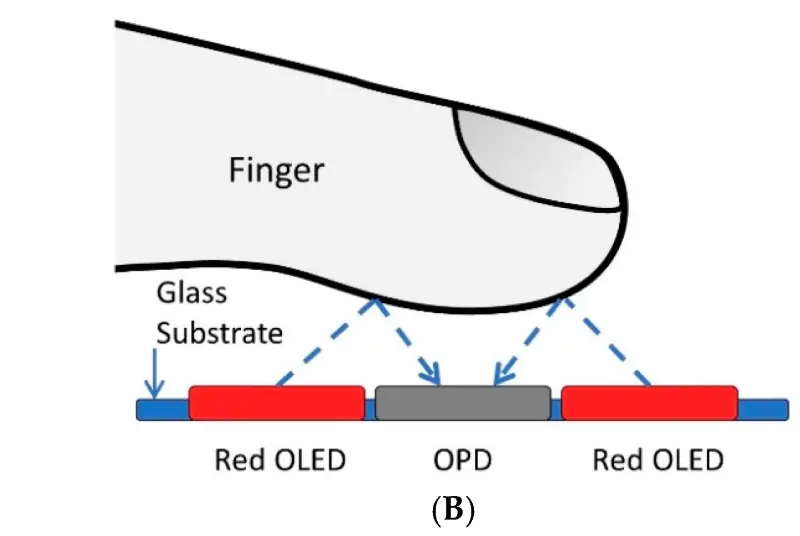
The detection principle of reflective blood oxygen saturation is basically the same as that of transmission blood oxygen saturation, with the only difference being the sensor. Reflective sensors are also composed of two wavelengths of light-emitting diodes and photosensitive elements, but the photosensitive element receives reflected light from the tissue. Due to the randomness of the movement of light in the organization, it is difficult to determine the exact detection area of the light received by reflective sensors. In a probabilistic sense, the light emitted from the light source propagates through the organization to the photosensitive element and travels along a banana like path. Therefore, the distance between the light source and the photosensitive element is an important parameter, usually set at 4-50mm.
Characteristics of Nail Pulse Oximeter
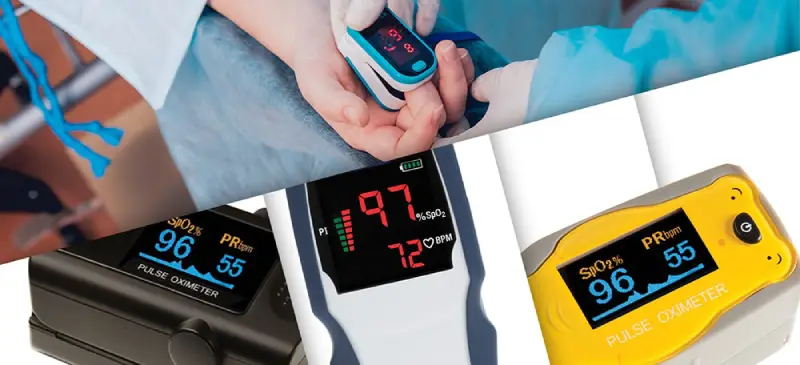
- Small and portable: The finger clip pulse oximeter is small in size, easy to carry, and can monitor our health status at any time.
- Non invasive measurement: The finger clip pulse oximeter uses optical technology to measure blood oxygen saturation and pulse rate, without the need for puncture, without causing harm to the body, and without the use of injection needles and injection tools.
- Accurate measurement: The finger clip pulse oximeter adopts advanced spectral technology and can measure very accurate blood oxygen saturation and pulse rate through LED light source sensors and probes.
- Quick response: The finger clip pulse oximeter has a very fast detection speed, and accurate measurement results can be obtained within a few seconds. These results can be immediately displayed on the screen, making it convenient for users to understand their health status in a timely manner.
- Easy to operate: The finger clip pulse oximeter is very simple to use, just insert the sensor into the fingertip to start measuring, without the need for complex settings and adjustments.
What Does A Nail Oximeter Measure
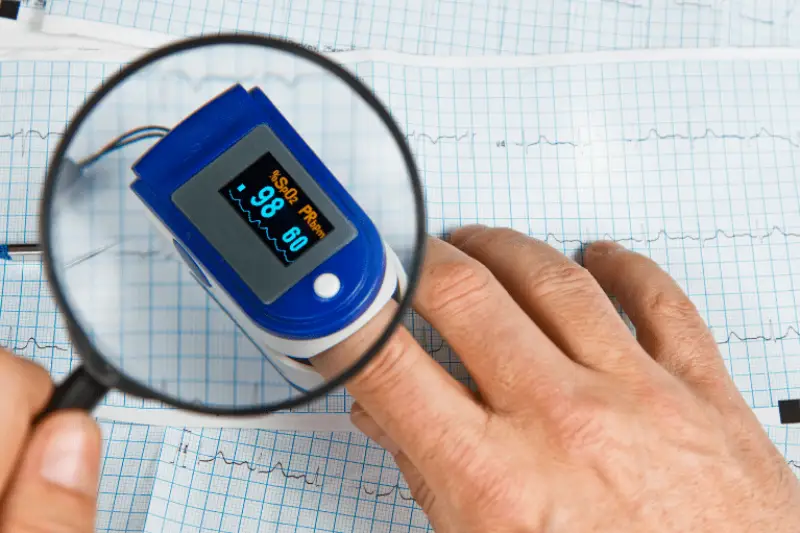
Measure blood oxygen saturation, as well as pulse, perfusion index, and other indicators. In clinical medicine, blood oxygen saturation is an important basic indicator, which mainly refers to the percentage of bound oxygen capacity in total blood volume. Normal people’s blood oxygen saturation and venous blood volume are 98% and 75%, respectively, which are important indicators reflecting the oxygen status in the body. The perfusion index reflects the pulsatile blood flow and mainly reflects the blood perfusion ability.
Is The Measurement of Nail Oximeter Accurate
Finger measurement of blood oxygen saturation is more accurate. Finger oxygen saturation measurement is a system transmitted through blood vessels on the surface of the skin, and the measurement result is the arterial oxygen saturation. If measured, it should be known that the blood oxygen saturation measured by normal individuals usually exceeds 95%, which is consistent with arterial blood oxygen saturation. If the venous oxygen saturation is very low, it is impossible to reach a blood oxygen saturation of over 90%. This means that measuring blood oxygen saturation can more conveniently, simply, and quickly reflect the patient’s blood oxygen status.
Nail Oximeter Measurement Normal Range
The normal range of blood oxygen measurement by pinching fingers is around 94%. If there are abnormalities, another abdominal CT examination may be necessary. If there is a low blood oxygen saturation during finger pinching, it is mostly caused by emphysema and hyperbaric oxygen, and may also be accompanied by various symptoms such as chest tightness and breathing difficulties. Multiple examinations are required to clarify the health status of the body and undergo physical conditioning under the guidance of a doctor.
Usage of Nail Oximeter
A commonly used device for measuring blood oxygen saturation and pulse rate with a finger pulse oximeter. The following are their usage methods:
- Turn on the device and place the fingertip between the light source and receiver of the pulse oximeter.
- Insert the fingertip into the fingertip to ensure its proper position. If the fingertips are too loose or too tight, it will affect the accuracy of the measurement.
- After confirming the correct position of the fingertip, press the power switch on the instrument.
- Wait for a few seconds, and the device will automatically measure your blood oxygen saturation and pulse rate, which will be displayed on the screen.
- After the measurement is completed, remove the finger cover from the fingertip.
Precautions:
- Before measurement, make sure that the fingers are dry, warm and free from any nail polish.
- Keep your fingers still during measurement to avoid affecting measurement accuracy.
- When conducting measurements, one should follow the doctor’s advice and avoid using a pulse oximeter too frequently.
- If the measurement accuracy is not high or there are abnormal situations, a doctor should be contacted in a timely manner for consultation.
Precautions for Nail Pulse Oximeter
- Before use, please ensure that the equipment has passed verification and certification, and meets relevant national standards;
- Wear the finger clip correctly. It is recommended to fit the rubber sleeve of the finger clip with the patient’s fingertip to avoid light interference;
- Before use, please clean the patient’s fingers to prevent infection with Fen;
- When using, try to avoid wearing anything inserted on your nails or fingers, and do not wear it on fingers with heavy water and oil stains;
- When using, pay attention to preventing the invasion of water and sweat, and regularly clean the wearing position;
- When one or both indicator lights on the frame quickly flash or switch, please replace the battery or charging device with a new one.
- If any equipment malfunction is found, please repair or replace it in a timely manner.
- Please consult a doctor or professional to confirm the equipment usage method to avoid harm to the patient.

